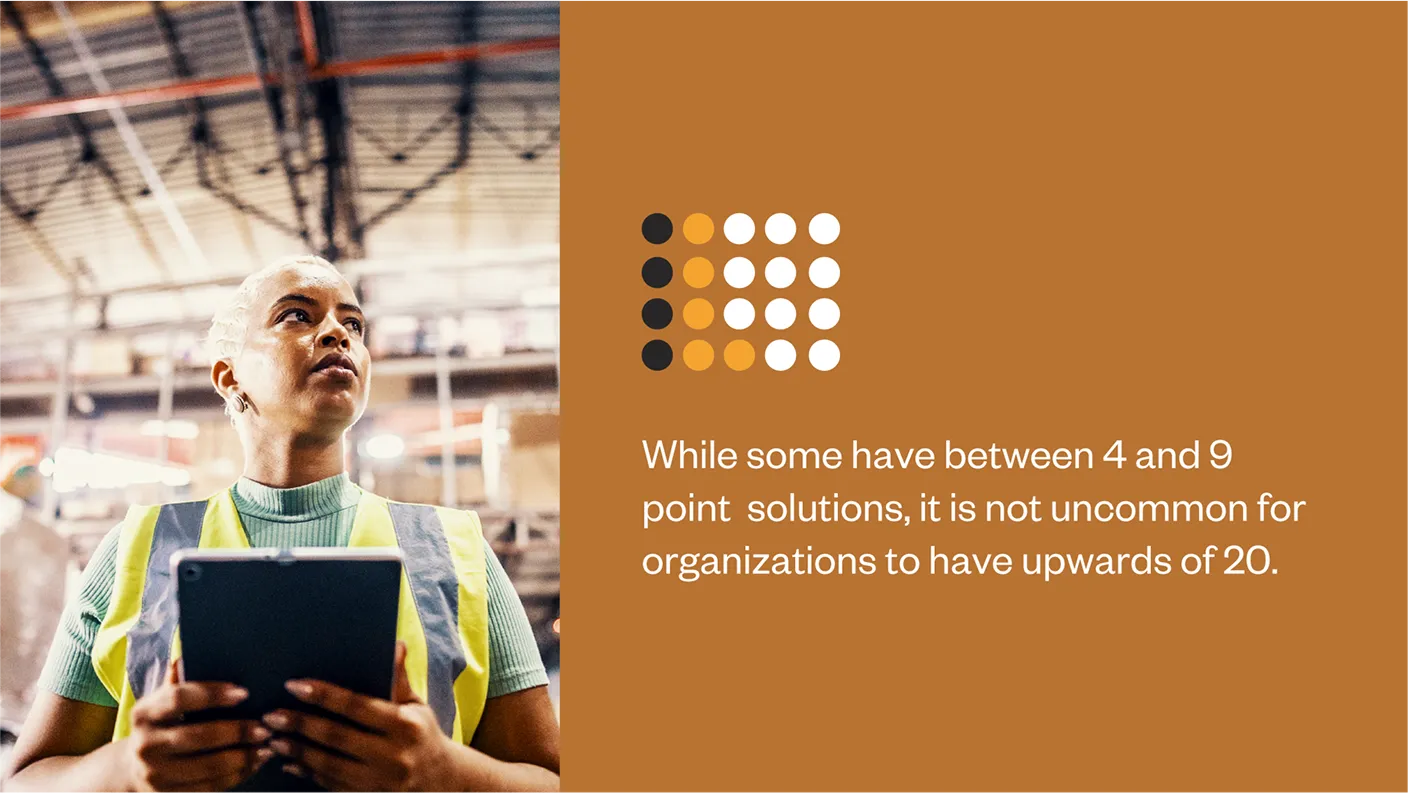Managing healthcare for employees has become an increasingly complex task. Despite employers’ best efforts, HR and benefits leaders continue to report feeling overwhelmed by the evolving demands of population health and system complexity.
The result?
Spiraling costs, uneven care, underutilized programs and widespread frustration across industries.
Far from being an abstract challenge, healthcare complexity directly impacts real-world health outcomes, productivity and employee satisfaction. In this report, we ask: What factors have led to the increased complexity of employer-sponsored healthcare? And, having understood them, how can we adapt to better support employers?

Population health complexity
As the American workforce continues to shift and evolve, it requires new, sophisticated healthcare solutions
People are getting sick sooner
More Americans than ever are living with chronic conditions, and at earlier ages. In 2023, 59.5% of young adults and 78.4% of middle-aged adults reported one or more chronic conditions; among young adults, incidence of at least one condition increased by 13% in a single decade.
The growing prevalence of chronic conditions is a major driver of increasing healthcare costs and one of many complex issues for employers that are addressed in this report.
Workforces are more diverse and more vulnerable to health inequities
More than 40% of the American population identified as non-white as of 2023, double what was reported in 1990. A more diverse workforce means a wider range of health needs, many of which remain unmet due to longstanding disparities in care. Underserved populations face higher rates of chronic disease but often lack access to preventive care and mental health services, health inequities that cost the United States $93 billion in excess medical care each year.

Workforce turnover is high
Since the mid-1980s, the median job tenure for U.S. wage and salary workers has held steady at five years, with an average annual turnover rate of 13.5%. For blue-collar workers, the rate is even higher at 15.6%. This level of churn makes it difficult for Human Resources (HR) professionals to know which benefits ought to be retained to effectively engage employees in health initiatives over the long term.
System complexity
This picture is further complicated by a profusion of options, data and a lack of efficient coordination between care teams and providers.
An overwhelming point solution ecosystem
As rates of chronic illness and healthcare costs continue to rise and whole health strategies become more important, point solutions have flooded the market. Today, there are literally hundreds (and possibly thousands) of point solutions available to HR professionals, who now report juggling anywhere between 4 to 9 point solutions on average, with some employers managing 20 or more. Many of these tools—which include point solutions designed specifically to navigate other point solutions—add value. But, in the absence of effective integration, members can find it challenging to take full advantage of the benefits available to them, while employers struggle to measure true performance and ROI.

Drowning in data
Data overwhelm can act as a force multiplier for system complexity as employers and HR professionals struggle to identify the needs of their population and determine how best to meet them. More member data is available for analysis than ever before, and with so much annual population turnover, it must be analyzed continually to maintain a solid understanding of member needs. Employers must also sift through data from multiple point solutions to evaluate their effectiveness, a task that comes at no small cost. Per a recent strategy survey conducted by the Business Group on Health, “managing and reassessing vendor partnerships are at the center of employers’ plans to address costs and improve performance,” with one study finding that the direct cost of doing so totaled $21.57 billion. This natural disincentive means that some employers avoid incurring such costs altogether, sticking with the same point solutions year after year regardless of whether they meet their employees’ needs.
Specialization
As modern medicine continues to advance, there has been a corresponding explosion of specialties and subspecialties within the medical field. As a point of comparison: In 1931, 84% of doctors identified as generalists, while in 2019, 75% defined themselves as specialists—a near-complete reversal of the status quo. Today, there are over 200 specialties and subspecialties in the United States, a state of affairs that underscores the necessity of clear communication and coordination between providers.
Fragmentation fuels inefficiency
An absence of coordination as employees navigate benefits, digital tools and the broader healthcare system is a key contributor to its increasing complexity. This leads to a number of negative consequences, including:
Lack of employee engagement
Employees confused about their benefits are less likely to take advantage of them, which means that regardless of how many “solutions” a plan might have, employers continue to pay the price in missed prevention, delayed care and avoidable claims.
Overtreatment
Accounting for up to 30% of healthcare costs, overtreatment is both a symptom and a cause of faulty coordination within the system, with individual patients—especially those with complex health conditions—often undergoing duplicative and wasteful treatments.
The Skai solution: Strategic integration
At Skai Blue Cross Blue Shield, we know that employers don't necessarily need more tools: They just need a better way to manage them. Our fully integrated strategy cuts through the fog of complexity on every level to enable smarter, less resource-intensive methodologies and a better experience for members across the board.
1. A partner who understands your workforce inside and out
With research indicating that 80% of health outcomes stem from socioeconomic, behavioral and environmental factors—known as social determinants of health (SDOH)—it’s apparent that understanding population health requires more than clinical data. This means going beyond medical records and claims to develop an intimate, holistic understanding of each member that can be used to tailor care to their particular health needs.
At Skai, we prioritize the collection of SDOH data in addition to more traditional medical records and claims, applying advanced data science models to build a complete picture of a workforce’s population and needs, present and future.

2. Clinical solutions that work smarter and harder
A clear picture of a population’s complex health is not all that helpful without a spectrum of high-quality solutions to meet those needs. Point solution ecosystems aren’t new. But the way we’ve built ours is. Our Innovations Hub features:
Diverse clinical solutions to meet wide-ranging population health needs, from chronic condition management to wellbeing, and everything in between.
Meticulous vetting and rigorous measurement using specific criteria to ensure high performance.
Third-party neutrality to ensure that solutions offered are always in the best interest of employers and members.
Deep and seamless integration with point solutions via cloud-based infrastructure that allows for faster, more frequent and more accurate data sharing—enabling better behind-the-scenes coordination and member care.
Total flexibility to integrate with an employer’s current vendors.
Streamlined contracting, invoicing, implementation, management and co-branded communications that remove the burden of point solutions administration.
Continuous re-evaluation of solutions to determine whether they remain cost-effective and relevant to a shifting population.
Ongoing market awareness to identify top-performing solutions that can fill unmet clinical needs.
The Innovations Hub is paired with a clinical approach that prioritizes:
A history of expertise in complex care management, with specialty teams supporting members through everything from cancer to diabetes to mental health.
A comprehensive and integrated team of nurses, social workers, dietitians, physicians, pharmacists and advocates, all working together to maximize member health.
Early risk prediction that looks beyond claims data for a more comprehensive picture to prevent catastrophic health events among high-turnover and high-risk populations.
Strategic outreach in which populations are grouped into cohorts, stratified by risk level and delivered solutions that meet each member’s unique needs.
A dedication to whole-person care that puts equal value on physical, mental and social needs to drive optimal outcomes.
A whole-system approach to medical pharmacy designed to drive savings and improve member experiences.
3. A simplified member experience
Members shouldn't have to try to make sense of multiple point solutions when it comes to taking care of their health. That’s why we’ve collaborated with Celeste to offer members a first-of-its-kind solution that integrates healthcare navigation, engagement and benefits management into a single app, making it possible for them to access everything they need to take care of their health, all in one place—like having a single front door for entry rather than dozens.

4. Smarter decision-making with real-time insight
Employers too often pay for solutions that sound good on paper but fail to meet their employees’ actual needs. At Skai, we believe in equipping employers with all the information they need to make confident decisions about the future. Illume, our analytics and reporting program, was built to turn complexity into clarity, empowering clients with a full understanding of what works and how to move forward. It does this through:
Industry-leading benchmarking capabilities for cost, quality and utilization by region, state, MSA and industry.
Market-level data that can be used to pinpoint opportunities to maximize quality and minimize cost by state, MSA and more—reducing time spent analyzing data and making more time to identify strategies for improvement.
Data incorporated from a broad variety of sources for a more complete picture of a health plan’s impact overall.
5. Behind-the-scenes coordination for better care
It’s essential that employers safeguard against unnecessary or inappropriate treatment in order to curb costs, minimize medical risk and improve member outcomes. To that end, our internal teams—including care management, social work, medical pharmacy, utilization management and more—are deeply integrated with each member’s care plan for immediate engagement and appropriate, high-quality care.

Future-ready benefits start here
Over the next five years, we can expect to see a clear distinction emerge between organizations that future-proof their health strategies and those that fall behind. With Gen Z continuing to enter the workforce, new care models on the rise and shifting expectations from the AI revolution, benefits must evolve to keep up with the changing times. At Skai, we’re not just solving for the complexity of today: We’re positioning employers to lead the future of healthcare and build benefits their workforces deserve.
Care to see what Skai could do for your team?
Contact us today to learn more.
